Contents
[Geological setting] [Lochkovian faunas and palynomorphs ...]
[Discussion ...]
[Glance at paleogeographical implications ...]
[Conclusions] and ...
[Bibliographic references]
UMR 6538 du CNRS "Domaines océaniques", UFR Sciences, 6 av. Le Gorgeu, CS 93837, 29238 Brest (France)
LNEG, Dep. de Geologia, Ap. 104, 7801-902 Beja (Portugal)
UMR 6538 du CNRS "Domaines océaniques", UFR Sciences, 6 av. Le Gorgeu, CS 93837, 29238 Brest (France)
LNEG, Dep. de Geologia, R. da Amieira, 4466-956 S. Mamede da Infesta (Portugal)
LNEG, Dep. de Geologia, Ap. 7586, 2720 Alfragide (Portugal)
3 rue Anatole Le Braz, 35830 Betton (France)
Manuscript online since December 31, 2010
In the Dornes syncline, southern Central Iberian Zone, Portugal, the uppermost levels of the Serra do Luação Formation up to now have been considered to be of Pridoli-Lochkovian? age because they lie immediately under the Dornes Formation, which is of Pragian age and is well defined stratigraphically. New paleontological elements including benthic faunas and palynomorphs allow us to confirm that the top of the Serra do Luação Formation is securely Lochkovian, for upper Lochkovian strata are present although relatively thin. The transition from the Serra do Luação to the Dornes formations and their lithostratigraphical relationship are now clear: the terrigenous succession belongs to the Serra do Luação Formation and the limestones represent the Dornes Formation. The benthic faunas clearly have North-Gondwanan affinities.
Lower Devonian; Lochkovian; Central Iberian Zone; Portugal; Brachiopods; Tabulate corals; palynomorphs; paleogeography.
R., J.M., Y., Z., J.T. & M. (2010).- Lower Devonian faunas and palynomorphs from the Dornes Syncline (Central Iberian Zone, Portugal): stratigraphical and paleogeographical implications.- Carnets de Géologie / Notebooks on Geology, Brest, Article 2010/09 (CG2010_A09)
Les faunes et les palynomorphes du Dévonien inférieur du Synclinal de Dornes (Zone Centre-Ibérique, Portugal) : signification stratigraphique et paléogéographique.- Dans le Synclinal de Dornes, sud de la Zone Centre-Ibérique, Portugal, le sommet de la Formation de Serra do Luação, était jusqu'à présent attribué au Pridoli-Lochkovien? par sa position relative sous la Formation de Dornes, mieux calée stratigraphiquement et d'âge Praguien. De nouveaux arguments paléontologiques concernant les faunes benthiques et les palynomorphes viennent confirmer que le sommet de la Formation de Serra do Luação appartient bien au Lochkovien, les derniers mètres représentant un Lochkovien supérieur fortement condensé. La transition entre les formations de Serra do Luação et de Dornes ainsi que leur position lithostratigraphique sont désormais éclaircies : les alternances silico-clastiques appartiennent bien à la Formation de Serra do Luação tandis que les niveaux calcaires appartiennent à la Formation de Dornès. Les faunes benthiques récoltées indiquent d'évidentes affinités Nord-Gondwaniennes.
Dévonien inférieur ; Lochkovien ; Zone Centre Ibérique ; Portugal ; Brachiopodes ; coraux Tabulés ; palynomorphes ; paléogéographie.
Lower Devonian strata occur in three structural domains in Portugal: the Central Iberian region, the Galicia-Trás-os-Montes area (in fact an allochthonous subzone of the Central Iberian domain), and the Ossa Morena Zone
(Fig. 1 ![]() ). The Dornes syncline is in the Iberian block and includes several lithostratigraphic units, two of which include lower Devonian deposits: the Serra do Luação and Dornes formations (,
1980).
). The Dornes syncline is in the Iberian block and includes several lithostratigraphic units, two of which include lower Devonian deposits: the Serra do Luação and Dornes formations (,
1980).
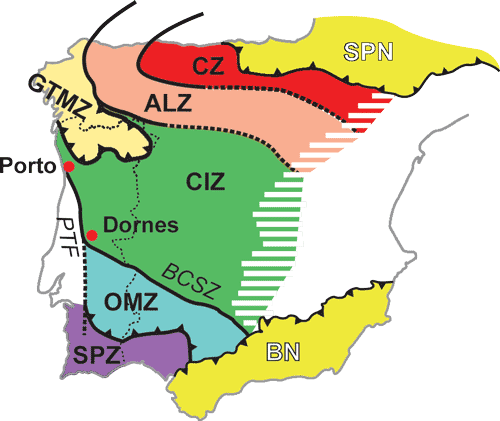
Click on thumbnail to enlarge the image.
Figure 1: Location of the Dornes Syncline in the structural elements of the Iberian Peninsula. GTMZ: Galicia - Tras-os-Montes Zone; CIZ: Central Iberian Zone; OMZ: Ossa Morena Zone; SPZ: South Portuguese Zone; CZ: Cantabrian Zone; ALZ: Asturo-Leonese Zone; BN: Betic Nappes; PTF: Porto-Tomar Fault; BCZS: Badajoz-Cordoba Shear Zone.
Here we focus on the lower unit (Serra do Luação Formation), a heterolithic succession about 200 m thick made up of alternations of sandstones, quartzites, siltstones and shales. Before our revision, this formation had been considered to be of late Ludlovian (Ludfordian) to early Pragian age (, 1980; et alii, 2000) based on 1) a lower to middle Ludlovian age assignment for the underlying Serra da Mendeira Formation, 2) rare occurrences of probable late Ludlovian and Pridolian microfossils respectively in the basal and middle parts of this formation and 3) the occurrence of Pragian macrofossils (brachiopods) in the overlying Dornes Formation. Additional paleontological data obtained from the Devonian of this area concern trilobites ( & , 1947), brachiopods ( & , 1967; , 1979; , 1980; et alii, 2000), and more recently crinoids and miospores ( et alii, 2000). Nevertheless, tectonic problems aside, the main obstacle to clear identification of stratigraphic boundaries in this area is the difficulty of finding well preserved fossils and precise data in older collections and publications. By modern standards the source of this old material is commonly poorly defined geographically, stratigraphically and sometimes zoologically. Thus, the exact stratigraphic position of the upper part of the succession, although undoubtly Devonian, has not been precisely established. One of the questions under discussion is to determine whether the detritic and calcareous succession of the Dornes spit section represents the Serra do Luação Formation (including the transition to the Dornes Formation) or is a part of the Dornes Formation itself, for above the basal limestone are silico-clastic deposits, well exposed in surrounding areas.
Fossils collected recently from the Dornes Syncline and in particular from the upper part of the Serra do Luação Formation ( et alii, 2000) allow more accuracy in delimiting the age of the series with faunas of Lochkovian (including early Lochkovian) age from three sections in the vicinity of the villlage of Dornes ( et alii, 2008).
As mentioned, the Serra do Luação Formation is overlain by the Dornes Formation, a 200 m succession of limestones, sandstones and mudstones. Its basal part is dolomitized and the upper part is not exposed in this area. A study to investigate the Pragian-Emsian faunas of this formation is currently in progress.
This section is located at the extreme end of the Dornes spit where a folded and locally faulted succession of mudstones, quartzites, conglomerates and sandstones crops out
(Fig. 2 ![]() ).
).
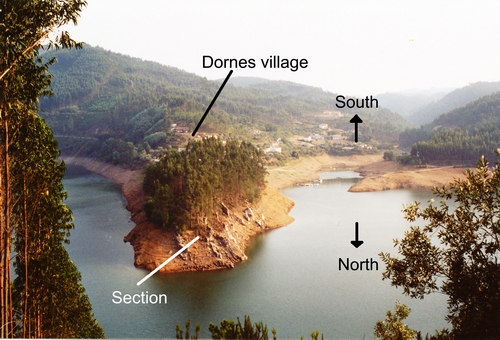
Click on thumbnail to enlarge the image.
Figure 2: The Dornes spit section viewed from the North during a period of water low stand level. Note the well exposed massive quartzites.
Thin conglomeratic and coquina beds occur in ferruginous sandstones in the upper part of the sequence. The exposure is topped by the dolomitic limestones of the Dornes Formation
(Fig. 3 ![]() ).
In the past the stratigraphic position of these strata was not clearly established:
(1980) and et alii
(2000) identified "siltstones & mudstones, undifferentiated" and "quartzites & sandstones, undifferentiated" with no age assigned. et alii
(2000) suggested that this entire succession might be part of the Dornes Formation.
).
In the past the stratigraphic position of these strata was not clearly established:
(1980) and et alii
(2000) identified "siltstones & mudstones, undifferentiated" and "quartzites & sandstones, undifferentiated" with no age assigned. et alii
(2000) suggested that this entire succession might be part of the Dornes Formation.
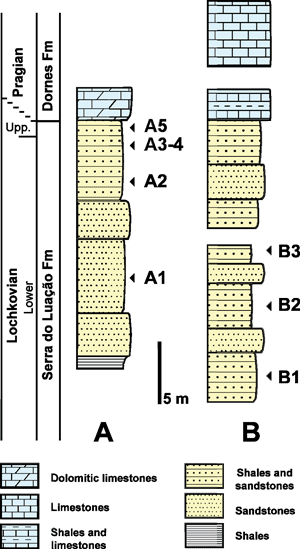
Click on thumbnail to enlarge the image.
Figure 3: Diagrammatic lithology of the Dornes spit (A) and Dornes - Vale Serrão road (B) sections in the vicinity of the Lochkovian-Pragian boundary and the sites of the localities sampled.
In a recent study ( et alii, 2008) five fossiliferous levels were identified in this succession, with the following content (from top to bottom):
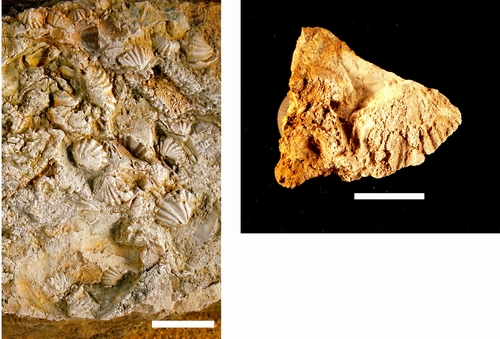
Click on thumbnail to enlarge the image.
Figure 4: Dornes spit section, Serra do Luação Formation. Shellbed with Howellella (Howellella) mercurii ssp. R , 1985, level A1 (left). Howellella (Hysterohowellella) lunae gourvenneci , & , 1993. Internal mold of an incomplete, partially dolomitized ventral valve; note the median rib in the sulcus; MG 10886; level A5 (right). Scale bar: 1cm.
Three formations exposed in the south side road cut of the long section on the northern flank of the Serra do Luação have been identified: the Vale Serrão, Serra Mendeira and Serra do Luação formations . The Serra do Luação Formation consists of about 200 m of heterolithic sandstones, siltstones and shales that, 25 m above its base, has yielded late Ludlow (Ludfordian) chitinozoans, acritarchs and a miospore assemblage and, 110 m above its base, Pridoli (post-Ludfordian) acritarchs (,
1980). Poorly preserved fragments of ? Leptostrophia sp. and an unidentifiable athyrid were also collected in the upper siltstones, a few meters below the top of the sequence, but did not allow a precise age determination. Later lower Lochkovian miospores assigned to the Emphanisporites micrornatus - Streelispora newportensis (MN) biozone and brachiopods were also identified ( et alii,
2000). This palynomorph assemblage and newly sampled brachiopod faunas
(Fig. 3 ![]() ) have been reviewed recently ( et alii,
2008). They confirm an early Lochkovian age (from top to bottom):
) have been reviewed recently ( et alii,
2008). They confirm an early Lochkovian age (from top to bottom):
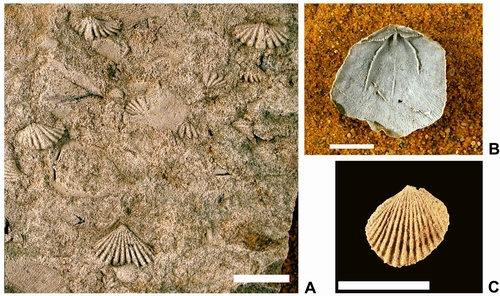
Click on thumbnail to enlarge the image.
Figure 5: Road cut Dornes-Vale Serrão section, Serra do Luação Formation, level B3. A: Shellbed with Howellella mercurii (top) and "Camarotoechia" sp. 2 (bottom). B: Mclearnites lecaroensis (, 1972). Latex mold of a ventral valve (elongate form); MG 10877. C: Mutationella sarrobi , 1972. Ventral valve. Scale bar: 1cm.
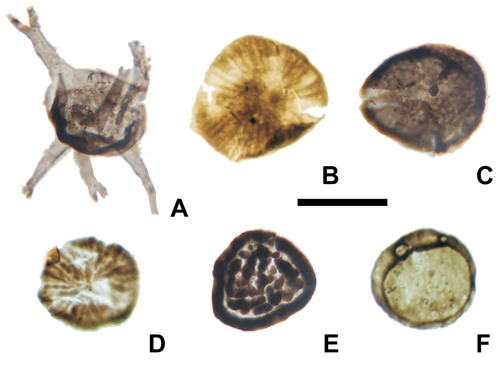
Click on thumbnail to enlarge the image.
Figure 6: Road cut Dornes-Vale Serrão section, Serra do Luação Formation, level B3. A: Diexallophasis remota () , 1977. B: Emphanisporites microornatus & , 1969. C: Chelinospora retorrida 1986. D: Emphanisporites multicostatus , 1978. E: Synorisporites sp. F: Laevolancis sp. Scale bar: 50µm.
Acritarchs are represented by the species Cymbosphaeridium sp., Dictyotidium sp., Diexallophasis remota , Ephelopalla sp., Gorgonisphaeridium sp., Micrhystridium stellatum , Multiplicisphaeridium sp., M. ramusculosum (), Neoveryhachium carminae , Onondagaella sp., Tyligmasona sp. and Veryhachium trispinosum & .
This locality is at the north of the storage dam, along a forest track previously sampled and studied by
(1980) who did not mention any fossils in the sequence. The lithological succession is quite similar to that of the section described previously although the sequence here is less complete and slightly faulted. Our specimens were collected from the eastern end of
Cooper's section. The faunal associations identified are similar to those described in the previous section. In particular, the following brachiopod species were recognized: Mclearnites (M.) lecaroensis, Mutationella sarrobi, Howellella (H.) mercurii, Proschizophoria maillieuxi, Schizophoria (R.) runegatensis, Platyorthis monnieri, Protathyris sp. cf. P. praecursor and Hexarhytis undata
(Fig. 7
![]() ).
).
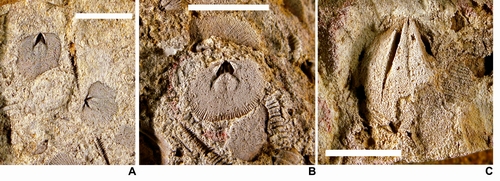
Click on thumbnail to enlarge the image.
Figure 7: Serra da Molhadinha section, Serra do Luação Formation. A-B: Platyorthis monnieri (, 1851), internal molds of dorsal valves, and ind. Tentaculitid. C: Schizophoria (Rhenoschizophoria) runegatensis? , 1972. Fragmentary ventral valve, internal mold; note the almost straight dental plates. Scale bar: 1cm.
The specimens of Ligulodictyum ligulatum from Dornes are identical with L. ligulatum from the Landévennec Formation of the Rade de Brest. In the Armorican Massif, L. ligulatum appears in the middle Member of the Landévennec Formation ("middle" lower Lochkovian) and its uppermost known occurrence is from the lower part of the Armorique Formation (early Pragian) where the specimens are rare and smaller (, 1980). The Dornes specimens resemble more closely the forms in the Landévennec Formation than those of the Armorique Formation. The species is also reported from the upper member of the Carazo Formation (lower Lochkovian, Spain). This supports a Lochkovian age: early Lochkovian (but not early lower) or late Lochkovian (but not late upper).
Mclearnites (M.) lecaroensis, Platyorthis monnieri and Proschizophoria? maillieuxi are known in the Landévennec and Gahard formations (mainly lower Lochkovian) (France) (, 1972), in the lower part of the Rañeces-La Vid Group (lowermost Lochkovian), in the upper part of the Carazo Formation and the lower part of the Lebanza Formation (lower Lochkovian) (Spain). Schizophoria (R.) runegatensis is present in the Landévennec Formation and was also identified in the upper part of the Carazo Formation and in the lower part of the Lebanza Formation (Northern Spain), all of early Lochkovian age.
Howellella (H.) mercurii ssp. R was described by in Celtiberia, from the lowermost Lower Gedinnian (level d1bß, Luesma Formation) (, 1985). A related but slightly larger form is known from the early Lochkovian of the Landévennec Formation (lower part of the middle member) in the Armorican Massif (, 1989). Mutationella sarrobi was described in the Landévennec Formation (lower Lochkovian; Armorican Massif, France) (, 1972).
Furthermore, the forms of Protathyris identified here are close to the P. praecursor described by (1929) in the Borshchov Formation of Podolia, Ukraine (lower Lochkovian). It is also known in Germany (Flaserschiefer), Northern France (Groupe de Liévin), and Morocco (Group of the Rich); all are of Lochkovian age.
The late Lochkovian age of the uppermost levels of the Serra do Luação Formation is attested by the presence of Howellella (Hysterohowellella) lunae gourvenneci, a species characterised by a typical sinal median rib, that had been reported only at its type locality in Celtiberia (Poyales, level d2aß5, Nogueras Formation, middle upper Lochkovian) ( et alii, 1993).
The assemblages identified here are in the Emphanisporites micrornatus - Streelispora newportensis (MN) Biozone of early Lochkovian age ( et alii, 1987; , 1989), based on the presence of the zonal key species E. micrornatus, together with Streelispora sp. and Chelinospora retorrida. The lowermost subzone (N) of Biozone MN was not clearly identified (the genus Streelispora is present but not identifiable to a specific level) but the overlying subzone (R), characterized by C. retorrida is present in the section and indicates an early Lochkovian age.
These new data clearly demonstrate that the first three levels (A1-A3) of the Dornes spit section are of early Lochkovian age and the upper level (A5) is late Lochkovian. Considering its paleontological content, the entire section, the dolomitic limestones excepted, can be referred assuredly to the Serra do Luação Formation and can no longer be assigned to the Dornes Formation of Pragian age. This assertion is supported by their discrete lithologies in the type locality defined by (1980): Serra do Luação Formation "interbedded sandstones, siltstones and quartzites" and the Dornes Formation "sequence of limestones, sandstones and mudstones", the basal unit a massive limestone. In another section, North of Dornes, the change from sandstone to limestone is less abrupt. The transition is in alternations of calcareous sandstones and limestones, so in this sequence the lower limit of the Dornes Formation is not determinable lithologically, for in the succession there is nothing to indicate the location of the base of the Dornes Formation. So it seems more accurate to consider the first occurrence of massive limestones as the basal component of the Dornes Formation, for in other areas of the Ibero-Armorican domain, near (i.e. slightly below) the Lochkovian-Pragian boundary, calcareous beds overlie sandy sequences. Strata of Lochkovian age are condensed here: lower Lochkovian faunas have been identified from exposures near the terminal beds of the Dornes spit and upper Lochkovian faunas are present only a few meters below the dolomitic limestones of the overlying Dornes Formation.
The data obtained from the road cut section (levels B2-B3) also indicate a lower Lochkovian age, as the macrofauna and the palynomorph assemblages both demonstrate, and the same can be said of the Serra da Molhadinha section. Thus most of the upper beds of the Serra do Luação Formation are clearly dated early Devonian (Lochkovian); only its last few meters contain fossils of late Lochkovian age, so the succession seems to be very condensed in this area. Unfortunately the dolomitization of the basal limestone of the Dornes Formation obliterated all fossils, so its assignment (upper Lochkovian or lower Pragian) remains indeterminate. If the massive limestone is eventually determined to be Lockhovian, the upper Lochkovian succession would be somewhat less condensed than is assumed here. The study of higher levels in the series, currently under investigation, may bring some light on this matter.
Despite its southernmost location in the Central Iberian Zone (CIZ), the Dornes succession is quite different paleontologically and lithologically from that of the adjacent Ossa Morena Zone (OMZ) which is in a more distal area of the marine platform. In the OMZ a shaly, often ampelitic succession is exposed, ranging in age from Ordovician to Emsian that yields the first benthic faunas. In the South Portuguese Zone (SPZ), paleontological data are lacking or scarce: the oldest deposits in this domain, dated from spores, are of Lower Givetian age. So our results confirm that the Porto-Badajoz-Cordoba lineament, including the Porto-Tomar fault and the Badajoz-Cordoba shear zone
(Fig. 1 ![]() ), constitutes a major and effective barrier for the distribution of benthic faunas during this period of time (early Devonian, late Lochkovian) between the CIZ and the OMZ and SPZ.
), constitutes a major and effective barrier for the distribution of benthic faunas during this period of time (early Devonian, late Lochkovian) between the CIZ and the OMZ and SPZ.
Six of ten identified brachiopod species from Dornes (Table
1 ![]() )
are known only in peri-Gondwanan areas; the others are cosmopolitan. The strongest observed affinities (up to the specific level) are with faunas of the Armorican Massif thus confirming the model proposed by et alii
(1990)
(Fig. 8
)
are known only in peri-Gondwanan areas; the others are cosmopolitan. The strongest observed affinities (up to the specific level) are with faunas of the Armorican Massif thus confirming the model proposed by et alii
(1990)
(Fig. 8 ![]() ), since McLearnites lecaroensis, Platyorthis monnieri, Proschizophoria maillieuxi, Hexarhytis undata, Howellella mercurii or Mutationella sarrobi are common to the two areas. Such similarities between Medio North Armorican Domain and CIZ have been mentioned previously (,
2002) in particular as related to Ordovician times, but also to the Siluro-Devonian, although this later entity is much less documented from a paleontological point of view.
), since McLearnites lecaroensis, Platyorthis monnieri, Proschizophoria maillieuxi, Hexarhytis undata, Howellella mercurii or Mutationella sarrobi are common to the two areas. Such similarities between Medio North Armorican Domain and CIZ have been mentioned previously (,
2002) in particular as related to Ordovician times, but also to the Siluro-Devonian, although this later entity is much less documented from a paleontological point of view.
| Armorican Massif | Spain | North Africa | Meguma Terrane | South Baltica | ||
| Gondwanan elements |
Ligulodictyum ligulatum | |||||
| McLearnites lecaroensis | ||||||
| Schiz. (R.) runegatensis | ||||||
| Proschiz. maillieuxi | ||||||
| How. mercurii ssp. R | ||||||
| How. lunae gourvenneci | ||||||
| Mutationella sarrobi | ||||||
| Other elements | Platyorthis monnieri | |||||
| Howellella mercurii | ||||||
| Hexharythis undata | ||||||
| Protathyris praecursor | ||||||
Table 1: Table summarizing the paleogeographical distribution of some brachiopod and corals species identified in the Lower Devonian of the Dornes area.
Strong affinities also exist with Spain (Asturo-Leonese area and Celtiberia) for most of the Portuguese species, except Protathyris praecursor, have been recognized in Spain, one of them being endemic in the Iberian Peninsula: Howellella lunae gourvenneci. Moreover, Mutationella sarrobi is probably present, but is misidentified as M. barroisi in Spain, although further investigation is required to confirm this.
Concerning other peri-Gondwanan domains, it is noteworthy that four species are shared with North Africa (Platyorthis monnieri, Protathyris praecursor, Hexarhytis undata and Howellella mercurii), although the wide distribution of these species makes their presence there less significant with regard to Paleozoic palaeogeography. It is also noteworthy that Schizophoria (R.) runegatensis and the North African species S. (R.) torkozensis , 1999, are very closely related. Four species are also common to, or are very closely related to, those identified from the Meguma Zone, Nova Scotia (Canada), two of them (McLearnites lecaroensis and Schizophoria runegatensis) having a typical North-Gondwanan affinity. This is to say that during the Early Devonian the closure of the Rheic Ocean had begun and allowed some faunal exchanges between Meguma and North Gondwana ( et alii, 1997).
Although four (five if Mutationella barroisi is included as a counterpart of M. sarrobi) species are shared with the Rhenish domain (Ardennes, Germany, Podolia, Southern Great Britain), all of them are cosmopolitan and cannot be considered as significant paleogeographical indicators, although the wide distribution of some of these taxa may be due to narrowing of the Rheic Ocean during the Early Devonian.
During the Early Devonian, the genus Ligulodictyum has a peri-Gondwanan distribution (, 2007). Occurrences are known in France (Armorican Massif), Spain (Cantabrian Mountains and Palencia), Algeria (Tindouf Basin, Ougarta), Morocco (Anti-Atlas), Turkey, Australia (East-Central Victoria) and New Zealand (Takaka Terranes). The occurrences postulated in South China and the Altaï can be ignored (, 2007).
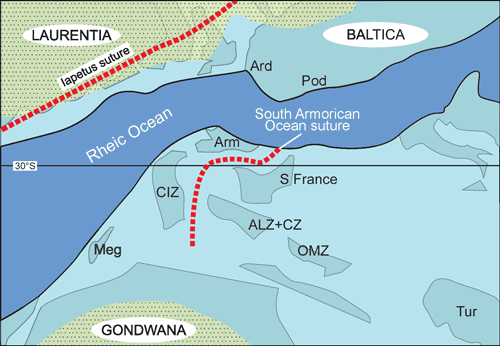
Click on thumbnail to enlarge the image.
Figure 8: Sketch map of Early Devonian paleogeography (after et alii, 1990, modified). ALZ+CZ: Asturo-Leonese and Cantabrian Zones; Ard: Ardenno-Rhenish Domain; Arm: Armorican Massif; CIZ: Central Iberian Zone; Meg: Meguma terrane; OMZ: Ossa Morena Zone; Pod: Podolia; dotted areas: land. The South Portuguese Zone is not indicated here and is thought to be located on the Northern margin of the Rheic.
This study confirms once again the close relationships between the Central-Iberian Zone, the Asturo-Leonese Zone and the Armorican Massif during the Lochkovian. That relationship contradicts the paleomagnetic models which assume the presence of a Prototethys Ocean separating the Armorica plate from North Gondwana in Early Devonian times. An
Ibero-Armorican domain closely related to and part of North Gondwana is a more likely alternative and these new data reinforce such a model
(Fig. 8 ![]() ). On the other hand, both paleontologically and lithologically, the CIZ is clearly distinguishable from the South Portugal domains that are obviously more distal.
). On the other hand, both paleontologically and lithologically, the CIZ is clearly distinguishable from the South Portugal domains that are obviously more distal.
Our determination of the age of the upper boundary of the Serra do Luação Formation makes possible the addition of a new element, stratigraphically well established, to the chronology of Early Devonian paleogeographic reconstructions in this region.
These new data show that the upper part of the Serra do Luação Formation is of Lockhovian age as indicated by macrofossils (mainly brachiopods) and miospore assemblages. They improve biostratigraphic correlation with the other regions of Portugal, mainly the Central Iberian Zone (Mação and Portalegre), and with Spain (Celtiberia, Palencia, Asturias), and France (Armorican Massif). These faunas show clear North Gondwanan affinities.
Authors aknowledge anonymous reviewer for improvement in English. This study is a contribution to the projects ICCTI/French Embassy (n° 506B0) "The Devonian of Portugal and of the Massif armoricain (France): stratigraphy, biostratigraphy and paleogeography. Implications on the southwestern European part of the Variscan Chain" and GRICES/CNRS (n° 20158) "The Siluro-Devonian transition in Portugal (northern areas) and in France (Massif armoricain) : stratigraphy, sedimentology, biostratigraphy, biogeography, petrography and geochemistry".
E., J., D., J.M., D., R., J., H. & F. (1997).- Biostratigraphie et paléobiogéographie du Siluro-Dévonien de la zone de Meguma (Nouvelle-Écosse, Canada).- Canadian Journal of Earth Sciences, Ottawa, vol. 34, p. 1295-1309.
P. (1985).- Howellella (Hysterohowellella) knetschi (Brachiopoda, Spiriferacea) aus dem tiefen Unter-Gedinnium Keltiberiens.- Senckenbergiana lethaea, Frankfurt am Main, vol. 65, issue 4/6, p. 297-326.
P., H. & J. (1993).- Lebensraum, Entstehung und Nachfahren von Howellella (Iberohowellella) hollmanni n.sg., n.sp. (Spiriferacea; Lochkovium, Unter-Devon).- Senckenbergiana lethaea, Frankfurt am Main, vol. 73, issue 2, p. 227-267.
A.H. (1980, unpublished).- The stratigraphy and palaeontology of the Ordovician to Devonian rocks of the area north of Dornes (near Figueiró dos Vinhos), central Portugal.- PhD thesis, University of Sheffield, 429 p.
A.H., M., K.J., K.M. (2000).- The Silurian to Devonian sequence in the Dornes area, Central Portugal.- Field trip of the VIII International Meeting of IGCP 421, Évora, p. 19-26.
R. (1989).- Brachiopodes Spiriferida du Dévonien inférieur du Massif armoricain. Systématique, paléobiologie, évolution, biostratigraphie.- Biostratigraphie du Paléozoïque, Brest, vol. 9, p. 281 p.
R., Y., Z., J.M., J., J.T., J. & M. (2008).- A reassessment of the Lochkovian (Lower Devonian) benthic faunas and palynomorphs from the Dornes region (southern Central Iberian Zone, Portugal).- Comunicações Geológicas, Lisboa, vol. 95, p. 5-25.
U. (1999).- Brachiopod fauna and age of the Assa Formation (Early Devonian, Dra Plains, southern Anti-Atlas, Moroccan Pre-Sahara).- Senckenbergiana lethaea, Frankfurt am Main, vol. 79, issue 1, p. 191-207.
R. (1929).- Les brachiopodes Gothlandiens de la Podolie polonaise.- Palaeontologia Polonica, Varsovie, vol. 1, 254 p.
M.T. & D. (1947).- Trilobites do Devónico Inferior português.- Comunicações Serviços Geológicos Portugal, Lisboa, vol. 28, p. 265-296.
J.T., J.M., Z., J., R. (2000).- Silurian to Carboniferous successions of the SW Iberian Massif (Portugal): The Dornes section.- Livro-guia da VIII International Field Meeting of IGCP 421 (Portugal), Univ. Évora, p. 15-42.
J.C. (1979).- O Devónico de Dornes (Paleontologia e Estratigrafia).- Comunicações Serviços Geológicos Portugal, Lisboa, vol. 65, p. 193-199.
Y. (Coord.) (1980).- Les Schistes et calcaires de l'Armorique (Dévonien inférieur, Massif armoricain). Sédimentologie - Paléontologie – Stratigraphie.- Mémoires de la Société Géologique et Minéralogique de Bretagne, Rennes, vol. 23, 317 p.
Y. (2007).- Histoire naturelle des Pleurodictyformes (Cnidaria, Tabulata) du Dévonien maghrébo-européen principalement (Morphologie, structure, microstructure, répartition stratigraphique et paléogéographique).- Mémoires de la Société Géologique et Minéralogique de Bretagne, Rennes, vol. 32, 138 p.
J.T. (1972).- Brachiopods of the Grès à Orthis monnieri Formation of Northwestern France and their significance in Gedinnian/Siegenian stratigraphy of Europe.- Palaeontographica, Stuttgart, (Abt. A), Band 138, p. 89-133.
M., F. & P.R. (1990).- Palaeogeographic evolution of southwestern Europe during Early Palaeozoic times. In: W.S. & C.R. (eds.), Palaeozoic Palaeogeography.- Geological Society of America, Memoir, Boulder, vol. 12, p. 411-419.
M. (2002).- Alternative approach to the Variscan Belt in southwestern Europe: Preorogenic paleobiogeographical constraints. In: J.R., R.D. Jr, R. & F. (eds.), Variscan-Appalachian dynamics: the building of the late Paleozoic basement.- Geological Society of America, Special Paper, Boulder, vol. 364, p. 1-15.
P. (1989).- Étude palynostratigraphique du Dévonien inférieur dans l'ouest de l'Europe.- Mémoires Explicatifs de la Carte Géologique de Belgique, Bruxelles, vol. 27, 453 p.
M., K., S., W. & P. (1987).- Spore stratigraphy and correlation with faunas and floras in the type marine Devonian of the Ardenne-Rhenish regions.- Review of Palæobotany and Palynology, Amsterdam, vol. 50, p. 211-229.
C. & D. (1967).- Le Dévonien du Portugal.- Proceedings of the International Symposium on the Devonian System, Calgary, p. 189-199.